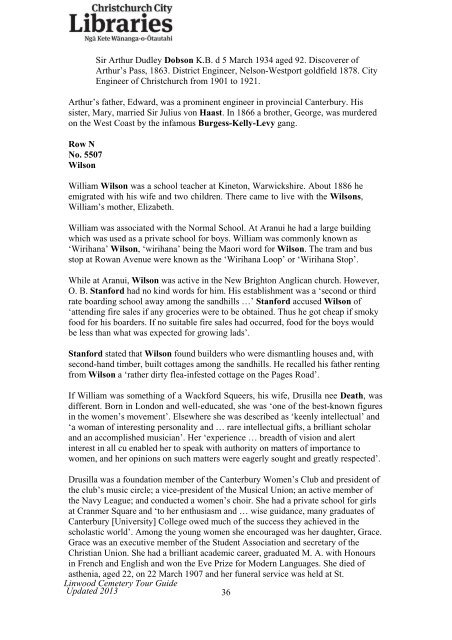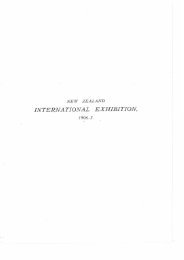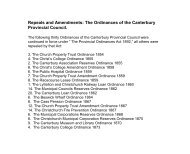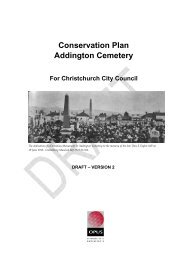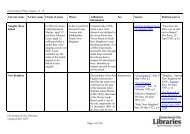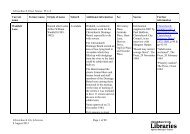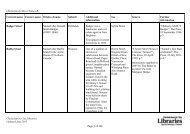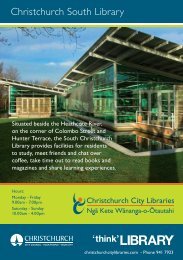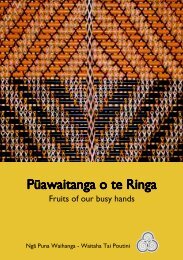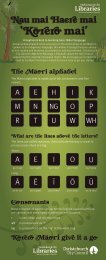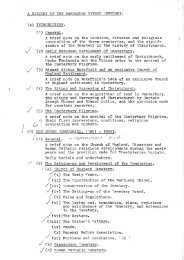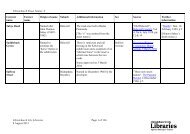Linwood Cemetery Tour Guide - Christchurch City Libraries
Linwood Cemetery Tour Guide - Christchurch City Libraries
Linwood Cemetery Tour Guide - Christchurch City Libraries
You also want an ePaper? Increase the reach of your titles
YUMPU automatically turns print PDFs into web optimized ePapers that Google loves.
Sir Arthur Dudley Dobson K.B. d 5 March 1934 aged 92. Discoverer of<br />
Arthur’s Pass, 1863. District Engineer, Nelson-Westport goldfield 1878. <strong>City</strong><br />
Engineer of <strong>Christchurch</strong> from 1901 to 1921.<br />
Arthur’s father, Edward, was a prominent engineer in provincial Canterbury. His<br />
sister, Mary, married Sir Julius von Haast. In 1866 a brother, George, was murdered<br />
on the West Coast by the infamous Burgess-Kelly-Levy gang.<br />
Row N<br />
No. 5507<br />
Wilson<br />
William Wilson was a school teacher at Kineton, Warwickshire. About 1886 he<br />
emigrated with his wife and two children. There came to live with the Wilsons,<br />
William’s mother, Elizabeth.<br />
William was associated with the Normal School. At Aranui he had a large building<br />
which was used as a private school for boys. William was commonly known as<br />
‘Wirihana’ Wilson, ‘wirihana’ being the Maori word for Wilson. The tram and bus<br />
stop at Rowan Avenue were known as the ‘Wirihana Loop’ or ‘Wirihana Stop’.<br />
While at Aranui, Wilson was active in the New Brighton Anglican church. However,<br />
O. B. Stanford had no kind words for him. His establishment was a ‘second or third<br />
rate boarding school away among the sandhills …’ Stanford accused Wilson of<br />
‘attending fire sales if any groceries were to be obtained. Thus he got cheap if smoky<br />
food for his boarders. If no suitable fire sales had occurred, food for the boys would<br />
be less than what was expected for growing lads’.<br />
Stanford stated that Wilson found builders who were dismantling houses and, with<br />
second-hand timber, built cottages among the sandhills. He recalled his father renting<br />
from Wilson a ‘rather dirty flea-infested cottage on the Pages Road’.<br />
If William was something of a Wackford Squeers, his wife, Drusilla nee Death, was<br />
different. Born in London and well-educated, she was ‘one of the best-known figures<br />
in the women’s movement’. Elsewhere she was described as ‘keenly intellectual’ and<br />
‘a woman of interesting personality and … rare intellectual gifts, a brilliant scholar<br />
and an accomplished musician’. Her ‘experience … breadth of vision and alert<br />
interest in all cu enabled her to speak with authority on matters of importance to<br />
women, and her opinions on such matters were eagerly sought and greatly respected’.<br />
Drusilla was a foundation member of the Canterbury Women’s Club and president of<br />
the club’s music circle; a vice-president of the Musical Union; an active member of<br />
the Navy League; and conducted a women’s choir. She had a private school for girls<br />
at Cranmer Square and ‘to her enthusiasm and … wise guidance, many graduates of<br />
Canterbury [University] College owed much of the success they achieved in the<br />
scholastic world’. Among the young women she encouraged was her daughter, Grace.<br />
Grace was an executive member of the Student Association and secretary of the<br />
Christian Union. She had a brilliant academic career, graduated M. A. with Honours<br />
in French and English and won the Eve Prize for Modern Languages. She died of<br />
asthenia, aged 22, on 22 March 1907 and her funeral service was held at St.<br />
<strong>Linwood</strong> <strong>Cemetery</strong> <strong>Tour</strong> <strong>Guide</strong><br />
Updated 2013<br />
36


